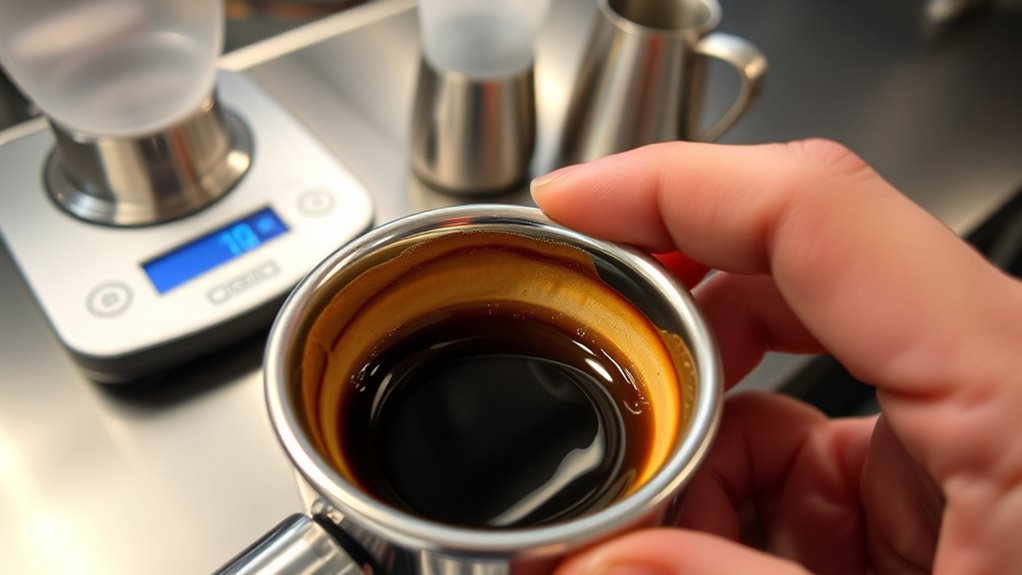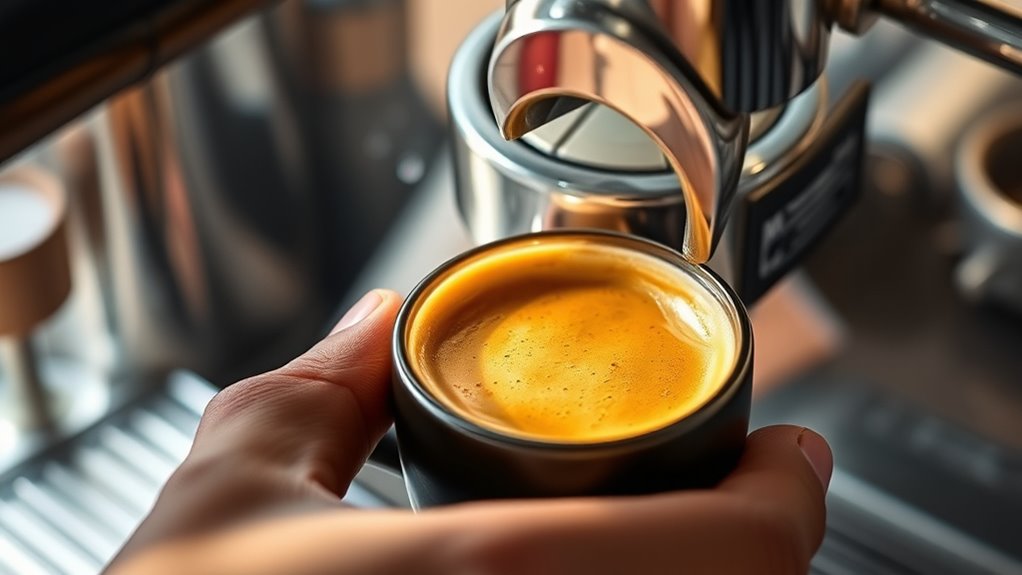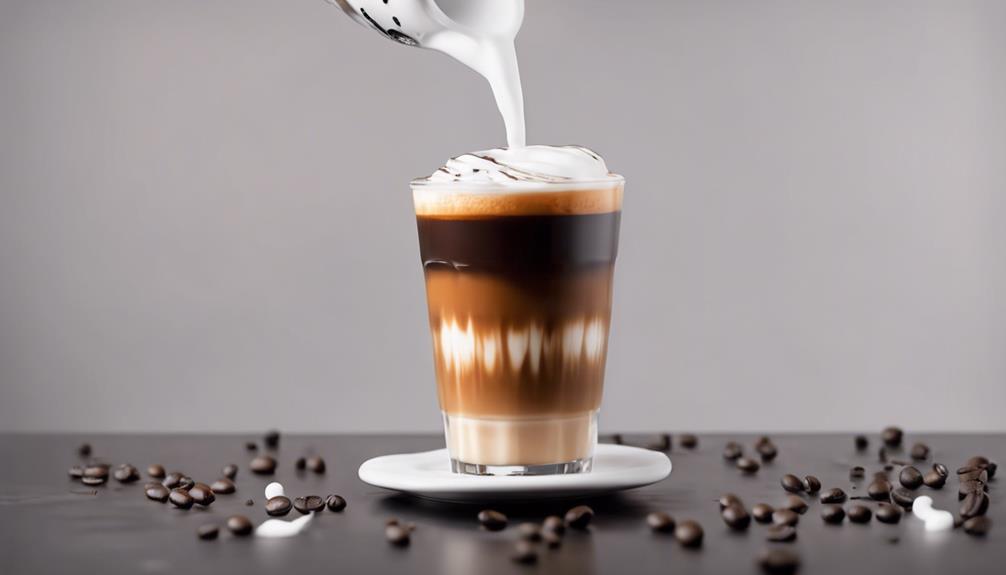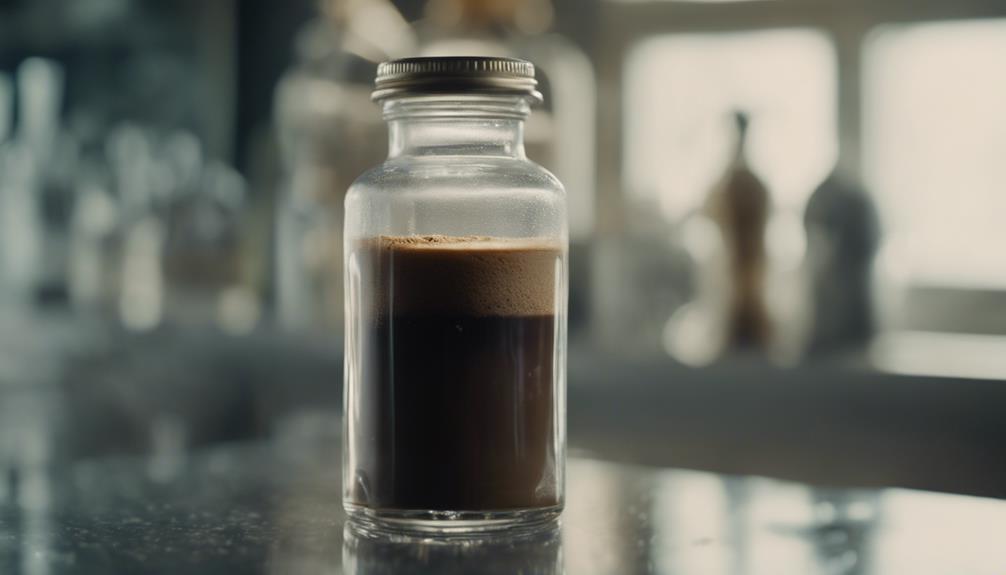If your espresso has issues like sourness, bitterness, weak crema, or blonding, check your grind size—coarse leads to sour shots and fine causes bitterness. Also, guarantee your shot timing is consistent, and your machine is well-maintained and properly calibrated. Use even tamping to prevent channeling and uneven extraction. Small adjustments can make a big difference, and you’ll reveal more tips to perfect your shot as you explore further solutions.
Key Takeaways
- Adjust grind size to balance shot timing and prevent under- or over-extraction.
- Maintain consistent brew temperature and pressure through regular machine calibration.
- Ensure proper tamping technique to promote even water flow and prevent channeling.
- Clean and maintain equipment regularly to avoid buildup and uneven extraction.
- Troubleshoot flavor issues by modifying grind, tamping, or temperature to address sourness, bitterness, or blonding.

Espresso can be a challenging brew to perfect, and common problems like sourness, bitterness, weak crema, blonding, and uneven extraction often stem from issues with grind size, temperature, extraction time, or machine maintenance. To troubleshoot these issues, you need to understand how each factor influences your shot.
Starting with grind size, it’s essential to dial it in correctly. A grind that’s too coarse results in under-extraction, giving you sour flavors and weak crema because water flows too quickly through the coffee. Conversely, a too-fine grind causes over-extraction, leading to bitterness and a dark, blonding appearance as the shot pulls too long. Properly adjusting the grind ensures even extraction and consistent flavor.
Adjust your grind size for balanced extraction—coarse for sourness, fine for bitterness.
Extraction quality heavily depends on shot timing and brew temperature. If your shot pulls too quickly, it suggests under-extraction, often due to an overly coarse grind or insufficient brew temperature. A shot that’s too slow indicates over-extraction, possibly from a grind that’s too fine or too high brew temperature. Maintaining consistent machine calibration is essential—your machine should deliver stable temperature and pressure.
Regular maintenance, including cleaning the portafilter, basket, and group head, prevents channeling and uneven extraction caused by coffee grounds not being evenly distributed or tamped properly. Proper tamping, applying even pressure, helps create a uniform coffee bed, which is critical for a clean, balanced shot.
Tamping is also key to preventing channeling—the uneven flow of water that bypasses coffee grounds and results in inconsistent flavors. An unlevel tamp or damaged portafilter basket can cause water to find weak spots, leading to blonding or weak crema. Always ensure your portafilter is level and that you apply firm, even pressure.
Shot timing should be closely monitored—aim for a consistent extraction time (usually around 25-30 seconds). If your shot pulls too fast or too slow, adjust your grind size accordingly.
Additionally, machine calibration plays a significant role. Regularly check your machine’s temperature and pressure settings, and perform routine maintenance to avoid issues like stale beans or degassing that can weaken crema. Proper maintenance and calibration help guarantee your espresso machine operates at peak performance, providing the right brew temperature and pressure needed for ideal extraction.
Frequently Asked Questions
What Is the 10 Second Rule for Espresso?
The 10 Second Rule for espresso refers to watching the flow during the first 10 seconds of extraction. You want a steady, thin stream indicating proper extraction.
If it’s faster, your shot might be under-extracted, leading to sour tastes. If it’s slower or too thick, over-extraction can cause bitterness.
Monitoring this helps you tweak grind size, tamping, or machine settings to get the perfect, balanced shot every time.
What Are Four Defects That Can Happen With an Espresso Machine?
You want to know about defects that can happen with your espresso machine. Four common issues include inconsistent water pressure, which leads to uneven extraction and poor crema.
Leaking valves or gaskets can cause water or steam leaks, reducing efficiency.
Blockages in the steam wand or brew head result in low pressure and poor frothing.
Electrical malfunctions like flashing lights can interrupt your shot.
Over time, scale buildup and worn parts affect temperature and flavor.
Why Is My Espresso Not Extracting Properly?
You notice your espresso isn’t extracting properly, and it’s likely due to several factors. You might’ve inconsistent grind size, causing under- or over-extraction, or uneven tamping that leads to channeling.
Check your machine’s temperature and pressure settings, as incorrect levels can hinder extraction. Also, make sure your beans are fresh and properly roasted.
Adjusting these variables helps you achieve a balanced, flavorful shot every time.
What Is the 2 1 Rule for Espresso?
The 2:1 rule for espresso means your final brewed espresso should weigh about twice the dry coffee dose.
For example, if you use 18 grams of coffee, aim for around 36 grams of liquid espresso.
This ratio helps you achieve balanced flavor and proper extraction.
Keep in mind, though, that slight adjustments can suit your taste preferences or specific coffee beans.
Conclusion
Now that you know the common espresso problems and their solutions, you can troubleshoot with confidence. Remember to check your grind size, tamping pressure, and water temperature regularly. Don’t get discouraged by issues—most are fixable with simple adjustments. Keep experimenting and refining your process. With patience and practice, you’ll brew perfect espresso shots every time. Enjoy the journey to becoming an espresso pro, and savor the rich, delicious results.









